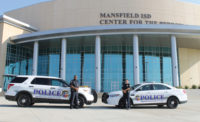Looking to make a change in your entryway security? With vast assortments of access and ID security solutions available, it can be difficult to wade through the options and choose the system best suited to your enterprise.
There are many risks and initiatives to address, including lockdown procedures, piggybacking or tailgating reduction, adequate throughput measures, installation requirements and post-installation service, not to mention company culture and aesthetic preferences. What might seem a deceptively simple task to an outside observer (“it’s just a door, right?”) can get infinitely more complicated when all of these factors are brought to the table.
Here is a decision-making aid to help you narrow down your entryway security product selection, including specific questions to ask manufacturers, dealers and integrators – as well as your own stakeholders – to determine the ideal entry solution for your enterprise.
-Claire Meyer, Associate Editor
With over 100 years of experience and a worldwide network of subsidiaries and manufacturing facilities, we have installed thousands of entry solutions and talked to end users all over the world. Based on our experiences, we’ve developed a comprehensive and consultative process called STARTSS®, a decision methodology to help end users avoid serious mistakes and make the best security entrance product decisions for the long term.
We can divide the entrance solution decision-making process into two parts. During the Before Installation phase, initial purchase decisions are often weighted towards Security, Aesthetics and ROI. After Installation, however, and once there is no going back, Throughput, Training, Service and Safety play more dominant roles.
By understanding the importance of each of the STARTSS decision factors and considering all of them in the context of the final product decision, you stand a much better chance of having the best overall decision-making experience that meets all your needs.
While initially aesthetics or security often naturally jump out as paramount in the decision process, all seven decision factors contribute to an effective security solution. Let’s take each of STARTSS factors in order and walk through a more comprehensive decision-making process.
Security is typically the top driver in the buying decision, but compare security features closely to ensure you obtain the right solution for your needs. Does the proposed entry solution offer these security features?
- Tailgating prevention
- Piggybacking prevention
- Support for anti-passback
- Integration with any access control system
- Minimal false rejection rates (3 percent or less)
Are you familiar with false rejection and the impact on the overall acceptance of daily users of the entry solution? Even when valid, users are rejected by a security entrance too frequently, and this can lead to complaints across the organization. So, it is important you get data on false rejection rates.
Throughput affects users directly on a daily basis. Before you commit to a particular kind of entrance solution, carefully calculate the peak throughput requirements for your building and entrances:
- Are there shifts that create heavy flows of traffic at certain times of day?
- Do you need one-way or two-way traffic at certain locations?
- Where will you provide access for the disabled or for large items?
- Does the security entrance allow for card stacking to maximize throughput?
- Does the security entrance use automatic or manual operation?
In measuring and evaluating throughput, it’s critical to manually count the number of people entering and leaving an entrance in a short period of time, such as five minutes, during a peak busy period. Do not rely on access control numbers especially if swing doors are present, as tailgating is likely to be occurring, and your count could end up too low.
Aesthetics are important initially, but they should not trump security, safety or throughput. The winning solution has to meet high aesthetic requirements without sacrificing the other key decision factors.
- Important aesthetic features should include:
- Architectural finishes
- Glazing options to complement any design/façade
- Workmanship and finishing
- Numerous top cover options for optical turnstiles
- Wide variety of product dimensions
Do not let aesthetics be the driving decision factor. A factor? Certainly, but only one of seven that must all be considered. Return on Investment (ROI) involves far more than the initial cost of the product.
ROI factors to consider:
- Does the entry solution replace or reduce manned security? ($114,000/year at $13/hour for one guard, 24/7/365 coverage, according to the U.S. Bureau of Labor Statistics, 2011)
- Robust construction means long product life
- Certified MTBF (mean time between failures) cycle data
- Energy savings
The average life of a security entrance product is 10-15 years. By weighing all the ROI factors, you are able to more accurately consider the true cost of making the buying decision.
Since most manufacturers do not install their products, technical training becomes critical in creating successful service providers for end users. It adds considerable value during installation and in maintenance over the life of the product.
Ask potential entry solution providers:
- Is installation, service, planned maintenance and post-installation technical training available for installers of the product?
- Do you provide a certification program for installers to keep them trained and up-to-date on new technologies?
- What training methods are used: hands-on factory and field training, pre-scheduled monthly webinars or private custom webinars?
- What are the training costs? Are they included in the overall solution or do they cost extra each time?
Service considerations typically come last, or not at all, when making a buying decision. Yet, during and after installation the level of service directly impacts continued operations and ROI.
Look for these features in a comprehensive service offering:
- Nationwide and global certified distribution partners
- Phone support: What percentage same-day resolution?
- Parts: What percentage same-day parts fulfillment? Are parts shipped from overseas?
- Is installation project management available?
- Preventative Planned Maintenance Agreements
Consider the impact of a delayed installation, unsatisfactory technical support and delayed parts availability. Problems in any of these areas could drag on for days, meanwhile your building is vulnerable while entrances are shut down, and nobody is happy. All because service was left out of the decision-making process.
Safety, too, is rarely discussed during the bidding process. However, it is the one factor that could quickly and tragically undermine the effectiveness and success of the project.
- Does the provider offer these safety features?
- Code compliance
- Meets all NFPA (National Fire Protection Association) fire egress codes
- Audible and visual communication for users
- Added sensors to protect users from moving components
- Speed/torque controls that can be adjusted to meet site operating conditions
- Instructional media to train new users
We’ve discussed seven crucial decision factors, but there is one more factor to consider. Entry solution providers must understand your company culture, and they must be able to help you communicate the best way for your culture to adapt to a new security entrance.
- How much exposure have your employees had to security entrances (other buildings, around town, previous employers, etc.)?
- How do you think employees will feel about your new security entrance?
- How will you plan to achieve buy-in from employees?
- When and how will you communicate the upcoming changes in security entrances?
- Are there any special needs – service animals, pets, elderly or disabled users, frequent deliveries in large carts – to be considered?
- Are all stakeholders involved in the decision process including the facility manager who will own the entrances once installed? Has the CEO been in on the decision-making process, is it possible he or she might decide the newly secure entryway is far from the image they wish to project?
The success (or failure) of a security entrance project must start and end with a comprehensive, consultative process that takes into consideration the full range of factors for discussion and ultimate decision. The STARTSS process outlined here is such a process. One that will help ensure that you and your enterprise stakeholders will be just as satisfied, if not more so, years after installation and not just when you’ve cut the ribbon on day one.
Do you have any suggestions or preferred practices in determining an entryway security solution? Let us know in the comments section at SecurityMagazine.com.
About the Author: Greg Schreiber is Vice President of Sales for Boon Edam Inc.
Product Showcase
There are many factors that can help ensure an effective, pleasant and secure entryway for your enterprise, from intercoms to turnstiles to badging and more. Check out these products for a quick peek at the market for enterprise entryway solutions.
Conveniently Identifies Visitors at Locked Doors
This JO Series Video Intercom from Aiphone features inside stations with easy to use touch buttons and a 7” video screen. It can accommodate one door and up to two inside stations for easy visitor management and communication. This intercom system recently won the iF Design Award for 2014 for its stylish and slim design.
Visit www.aiphone.com for more information.
Reduces Tailgating and Piggybacking at Secured Entry Points
Physical security entrance products from Boon Edam help mitigate risk and security staff supervision costs by electronically detecting piggybacking or tailgating attempts, providing substantial ROI opportunities. In June 2014, this Tourlock 180+90 security revolving door, among other Boon Edam solutions, was certified by Intertek Group PLC to conform with UL and CSA standards, enabling faster installations by eliminating the need for UL/CSA testing in the field.
Learn more at www.boonedam.us
Extends Elegant Access Control to Glass Entryways
This Securitron R100 Surface-Mounted Wireless Reader offers an aesthetically appealing way to install access control to glass entryways. Installation takes just minutes, requiring no drilling or pulling of wireless to the door. This electronic locking solution wirelessly transmits credentials for requests to entry.
Visit www.securitron.com to learn more.






